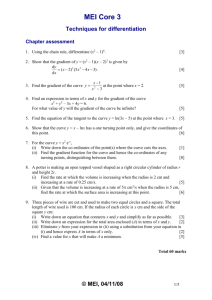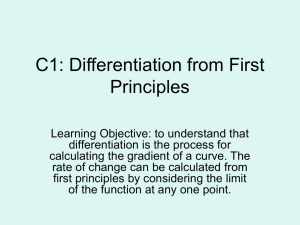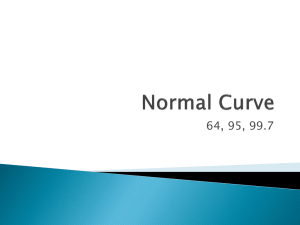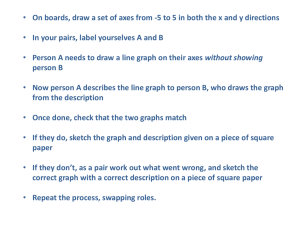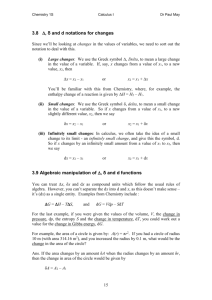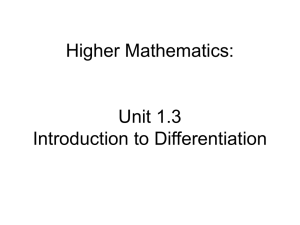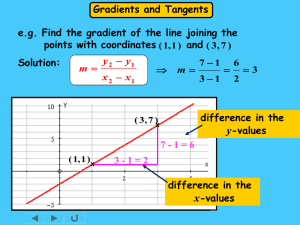Simple differentiation
advertisement
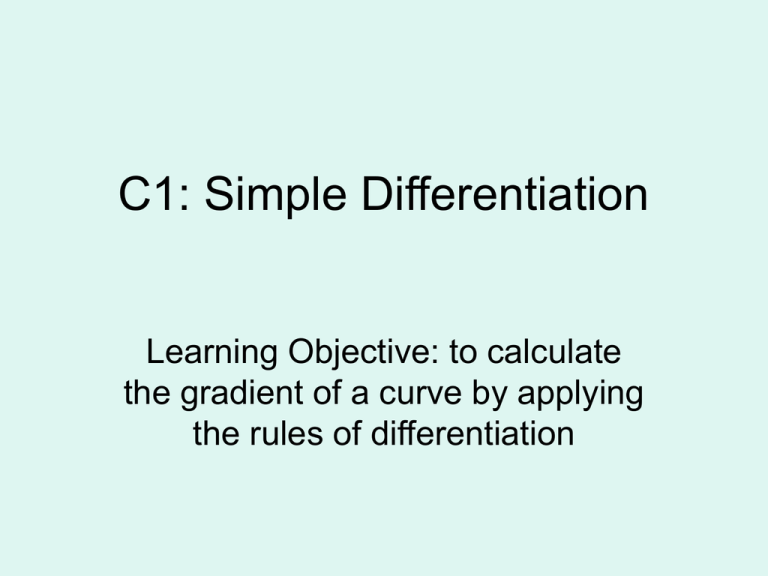
C1: Simple Differentiation Learning Objective: to calculate the gradient of a curve by applying the rules of differentiation The gradient of a curve The gradient of a curve at a point is given by the gradient of the tangent at that point. Look at how the gradient changes as we move along a curve: Differentiation If we continued the process of differentiating from first principles we would obtain the following results: y dy dx x x2 x3 x4 x5 x6 1 2x 3x2 4x3 5x4 6x5 What pattern do you notice? In general: If y x th e n n dy nx n 1 dx and when xn is preceded by a constant multiplier a we have: n If y = ax th e n dy dx = anx n 1 The gradient function So the gradient of the tangent to the curve can be calculated by differentiation. dy dx represents the derivative of y with respect to x. So if y = x3 then: dy = 3x 2 dx This notation can be adapted for other variables so, for example: ds dt represents the derivative of s with respect to t. If the curve is written using function notation as y = f(x), then the derived function can be written as f ′(x). Task 1 Differentiate 1. y = x4 2. y = 3x4 3. y = 5x3 4. y = 2x8 5. y = -5x6 6. y = x12 7. y = -0.5x2 8. y = 2.5x4 9. y = 15x8 10. y = 2/3 x3 Differentiation Find the gradient of the curve y = 3x4 at the point (–2, 48). Differentiating: dy = 12 x 3 dx At the point (–2, 48) x = –2 so: dy = 1 2( 2 ) 3 dx = 12 × 8 = 96 The gradient of the curve y = 3x4 at the point (–2, 48) is –96. Task 2 1. Find the gradient of the tangent of y = x4 at the point (3, 81). 2. Find the gradient of the curve whose equation is y = 3x2 at the point (2, 12). 3. Find the gradients of the curve y = 2x2 at the points C and D where the curve meets the line y = x + 3. You can apply the rules of differentiation to functions involving negative or fractional powers and for polynomials. Examples: 1. y = x-2 1. dy/dx = -2x-3 2. y = x1/2 2. dy/dx = ½ x-1/2 3. y = 3x2 + 5x - 6 3. dy/dx = 6x + 5 Task 3: Find dy/dx when y equals: 1. 2. 3. 4. 5. 6. 7. 8. 9. 10. 2x2 -6x + 3 ½ x2 + 12x 4x2 - 6 8x2 + 7x +12 5 + 4x – 5x2 x3 + x2 – x1/2 2x-3 1/3 x1/2 + 4x-2 5√x x3(3x + 1) Task 4: 1. Find the gradient of the curve whose equation is y = 2x2 – x – 1 at the point (2,5). 2. Find the y co-ordinate and the value of the gradient at the point P with x co-ordinate 1 on the curve with equation y = 3 + 2x - x2. 3. Find the co-ordinates of the point on the curve with equation y = x2 + 5x – 4 where the gradient is 3. 4. Find the point or points on the curve with equation f(x), where the gradient is zero: a) f(x) = x3/2 – 6x + 1 b) f(x) = x-1 + 4x. Second Order Derivatives You can repeat the process of differentiation to give a second order derivative. The notation d2y/dx2 or f’’(x) is used. Example: y = 3x5 + 4/x2 y = 3x5 + 4x-2 dy/dx = 15x4 -8x-3 d2y/dx2 = 60x3 + 24x-4 = 60x3 + 24/x4 Task 5: Find dy/dx and d2y/dx2 when y equals: 1. 12x2 + 3x + 8 2. 15x + 6 +3/x 3. 9√x – 3/x2 4. (5x + 4)(3x – 2) 5. (3x+ 8)/(x2) Task 6: Using different notation 1. 2. 3. 4. 5. Find dθ/dt where θ = t2 – 3t Find dA/dr where A = 2πr Given that r = 12/t, find the value of dr/dt when t = 3. The surface area, A cm2, of an expanding sphere of radius r cm is given by A = 4πr2. Find the rate of change of the area with respect to the radius at the instant when the radius is 6cm. The displacement, s metres, of a car from a fixed point at time t seconds is given by s = t2 + 8t. Find the rate of change of the displacement with respect to time at the instant when t = 5.

